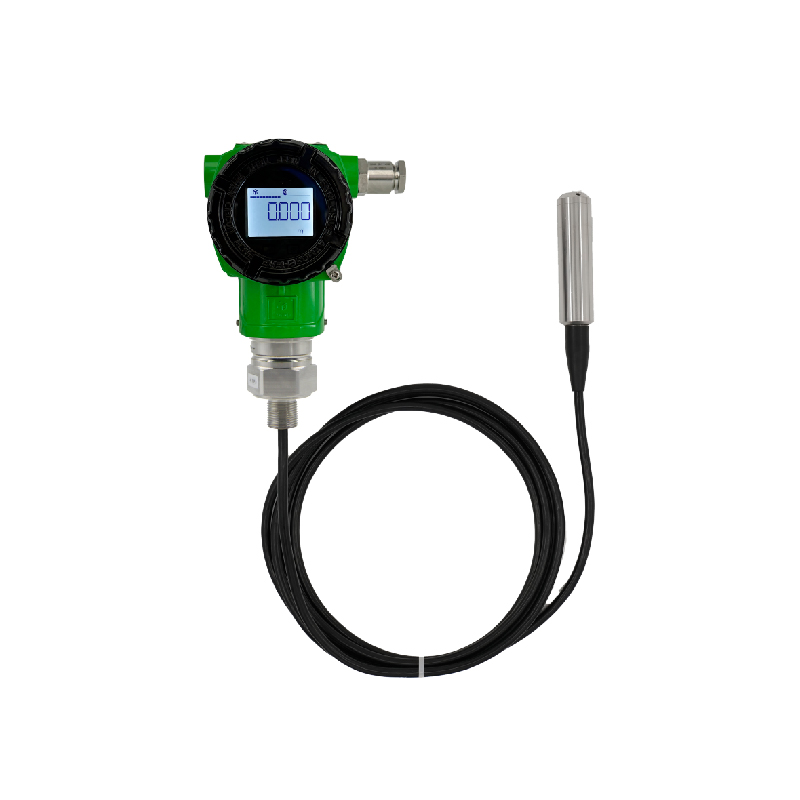In numerous industrial production fields and daily life scenarios, the accurate measurement of liquid levels is a crucial link in ensuring production safety, improving production efficiency, and guaranteeing product quality. The submersible level gauge, with its unique advantages, plays an important role in liquid level measurement. Let's delve into the relevant issues and applications of the submersible level gauge.
I. Working Principle of the Submersible Level Gauge
The submersible level gauge is based on the principle that the hydrostatic pressure of the measured liquid is directly proportional to its height. It uses advanced isolated diffused silicon sensitive elements or ceramic capacitive pressure sensitive sensors from abroad to convert the hydrostatic pressure into an electrical signal. After temperature compensation and linear correction, it is transformed into a standard electrical signal (usually 4 - 20mA, 0 - 5V, etc.) for output. In simple terms, when the level gauge is immersed in the liquid, the pressure of the liquid acts on the sensor of the level gauge. The sensor converts the pressure signal into an electrical signal, which is transmitted through a cable to the display instrument or control system, thus realizing the measurement and monitoring of the liquid level.

II. Advantages of the Submersible Level Gauge
Easy Installation
The installation of the submersible level gauge is very simple. Just immerse the probe of the level gauge directly into the liquid and then fix the cable. It does not require complex operations such as opening holes and installing flanges on the container wall. It is especially suitable for containers of various shapes and materials. Whether it is a round or square water tank, or a tank made of plastic or metal, it can be easily installed and used.
Precise Measurement
Using high-precision sensors and advanced signal processing technology, the submersible level gauge can provide accurate liquid level measurement data. It can measure the liquid levels of different media, including water, oil, acid and alkali solutions, etc., and can maintain a high measurement accuracy under different temperature and pressure environments, providing a reliable basis for the control and management of the production process.
Strong Adaptability
The submersible level gauge has good adaptability and can work normally in harsh industrial environments. Its sensor is usually encapsulated with stainless steel or anti-corrosion materials, which have the characteristics of corrosion resistance and wear resistance, and can resist the erosion of impurities, particles, and chemical substances in the liquid. At the same time, the level gauge can also adapt to different temperature ranges and can operate stably in both low-temperature and high-temperature environments.
Low Cost
Compared with some other types of liquid level measurement instruments, the price of the submersible level gauge is relatively low, and the installation and maintenance costs are also not high. It does not require complex supporting equipment and a large amount of manual operation, which can save a lot of cost for enterprises and is a liquid level measurement solution with high cost performance.
III. Application Fields of the Submersible Level Gauge
Water Treatment Industry
In places such as sewage treatment plants, waterworks, and pumping stations, the submersible level gauge is used to measure the liquid levels of water pools, water tanks, and sump wells. By monitoring the liquid level in real-time, the control system can automatically adjust the start and stop of the water pump according to the change of the liquid level, realizing the precise control of the water level, ensuring the normal operation of the water treatment process, and avoiding situations such as overflow or emptying.
Chemical Industry
In the chemical production process, various liquid raw materials and products are involved in storage and processing. The submersible level gauge can measure and monitor the liquid levels in reaction kettles, storage tanks, tank trucks, and other containers. In some corrosive chemical media, the submersible level gauge made of special anti-corrosion materials can accurately measure the liquid level, providing a guarantee for the safety and stability of chemical production.
Food and Beverage Industry
In the production and storage process of food and beverages, it is necessary to accurately control the liquid levels of various liquid raw materials, semi-finished products, and finished products. The submersible level gauge meets the food hygiene standards and can be used in food-grade liquids, such as the liquid level measurement of storage tanks for milk, juice, beer, etc., ensuring the hygiene of the production process and the stability of product quality.
Petroleum Industry
In the links of oil extraction, oil refining, storage, and transportation in the petroleum industry, the submersible level gauge is used to measure the liquid levels of oil wells, oil tanks, and oil depots. It can monitor the storage quantity of oil products in real-time, providing accurate data support for the production, transportation, and sales of petroleum. At the same time, it can also detect potential safety hazards such as oil product leakage in a timely manner, ensuring the safe production of the petroleum industry.
IV. Common Problems and Solutions in the Use of the Submersible Level Gauge
Measurement Error
Measurement errors may be caused by improper installation position of the level gauge, damage to the sensor, changes in the characteristics of the medium, and other reasons. The solutions include: ensuring that the level gauge is installed vertically in the liquid to avoid being affected by the flow of the liquid; regularly checking the working status of the sensor and replacing it in time if it is damaged; calibrating and correcting according to the actual characteristics of the medium.
Signal Transmission Problem
Unstable signal transmission or interference may lead to inaccurate or fluctuating liquid level data on the display instrument. Check whether the cable is damaged and whether the connection is firm. At the same time, take shielding measures to reduce the influence of external electromagnetic interference.
Corrosion Problem
If the level gauge is in long-term contact with corrosive media, it may cause corrosion to the sensor and the housing, affecting the measurement accuracy and service life. Select a level gauge made of suitable anti-corrosion materials, and regularly inspect and maintain the level gauge. If corrosion is found, deal with it in a timely manner.


